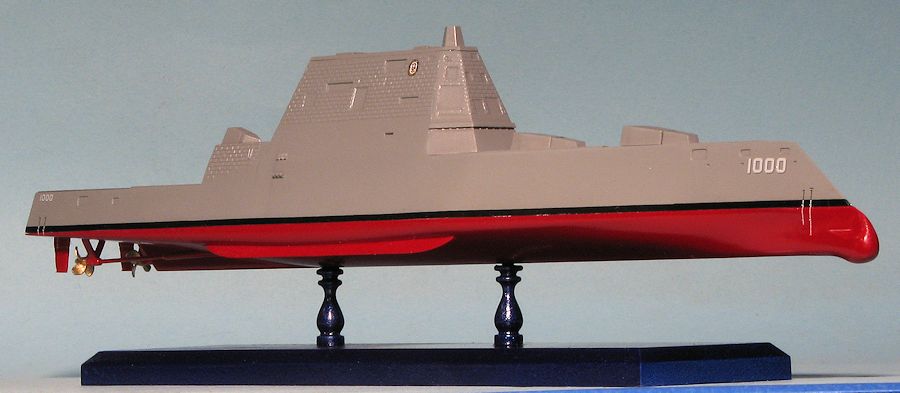
Black Label (Dragon) 1/700 USS Zumwalt DDG 1000
| KIT #: | 7141 |
| PRICE: | $38.99 SRP |
| DECALS: | One option |
| REVIEWER: | Scott Van Aken |
| NOTES: | New tool kit |

| HISTORY |
The hull classification symbol for the USS Zumwalt is DDG-1000, eschewing the guided missile destroyer sequence that goes up to DDG-118 (currently the last of the named Arleigh Burke-class destroyers), and continue in the previous "gun destroyer" sequence left off with the last of the Spruance-class, 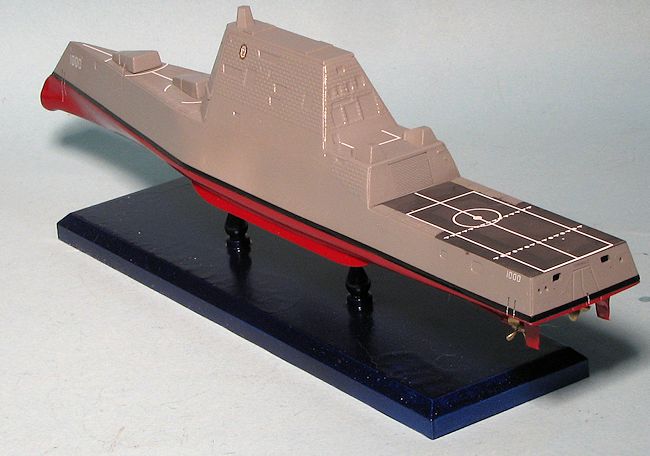 USS Hayler. With the production run of the Zumwalt-class limited to three units, plans are underway for a third "flight" of Arleigh-Burke-class destroyers.
USS Hayler. With the production run of the Zumwalt-class limited to three units, plans are underway for a third "flight" of Arleigh-Burke-class destroyers.
Many of the ship's features were originally developed under the DD21 program ("21st Century Destroyer"). In 2001, Congress cut the DD-21 program by half as part of the SC21 program. To save it, the acquisition program was renamed as DD(X) and heavily reworked. The initial funding allocation for DDG-1000 was included in the National Defense Authorization Act of 2007.
A contract worth $1.4 billion was awarded to General Dynamics on 14 February 2008 for the construction of USS Zumwalt at Bath Iron Works in Bath, Maine.
Full rate production officially began on 11 February 2009.
As of July 2008, the construction timetable was for General Dynamics to deliver the ship in April 2013, with March 2015 as the target for Zumwalt to meet her initial operating capability. However, by 2012, the planned completion and delivery of the vessel had slipped to the 2014 fiscal year.
The first section of the ship was laid down on the slipway at Bath Iron Works on 17 November 2011. By this point, fabrication of the ship was over 60% complete. The naming ceremony was planned for 19 October 2013, but was canceled due to the United States federal government shutdown of 2013.
Despite rumours that the launch of Zumwalt would be delayed until early 2014, the vessel was launched from its shipyard in Bath, Maine on 29 October 2013.
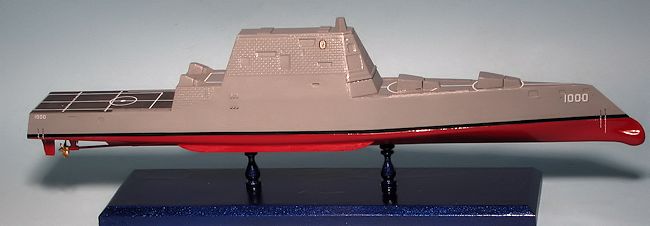 In January 2014, Zumwalt began to prepare for heavy weather trials. The trials will see how the ship and its instrumentation reacts to high winds, stormy seas, and adverse weather conditions. The ship's new wave-piercing tumblehome hull configuration is made to reduce her radar cross-section. Tests will involve lateral and vertical accelerations and pitch and roll. Later tests will include fuel on-loading, data center tests, propulsion events, X-band radar evaluations, and mission systems activation to finalize integration of electronics, currently 90 percent complete out of 6 million lines of code. These all culminate in builders trials and acceptance trials, with delivery for U.S. Navy tests in late 2014 with initial operating capability (IOC) to be reached by 2016.
In January 2014, Zumwalt began to prepare for heavy weather trials. The trials will see how the ship and its instrumentation reacts to high winds, stormy seas, and adverse weather conditions. The ship's new wave-piercing tumblehome hull configuration is made to reduce her radar cross-section. Tests will involve lateral and vertical accelerations and pitch and roll. Later tests will include fuel on-loading, data center tests, propulsion events, X-band radar evaluations, and mission systems activation to finalize integration of electronics, currently 90 percent complete out of 6 million lines of code. These all culminate in builders trials and acceptance trials, with delivery for U.S. Navy tests in late 2014 with initial operating capability (IOC) to be reached by 2016.| THE KIT |
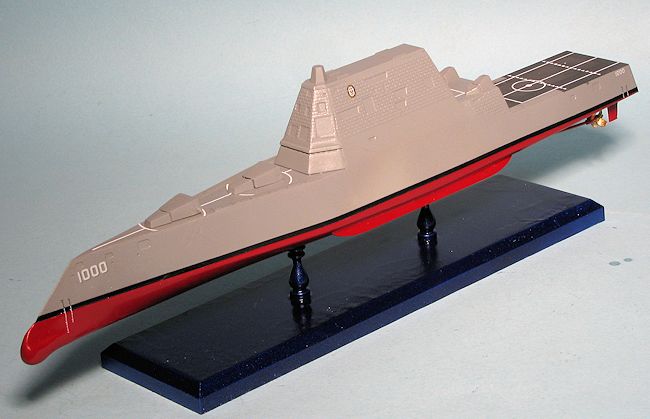 kit, but no fret. Means that my model will be without the drone. This is the second time I've gotten a ship kit from Dragon without the etched fret in the last 10 years. Trying to get a replacement the first time was an exercise in futility and that kit still sits unfinished.
kit, but no fret. Means that my model will be without the drone. This is the second time I've gotten a ship kit from Dragon without the etched fret in the last 10 years. Trying to get a replacement the first time was an exercise in futility and that kit still sits unfinished.| CONSTRUCTION |
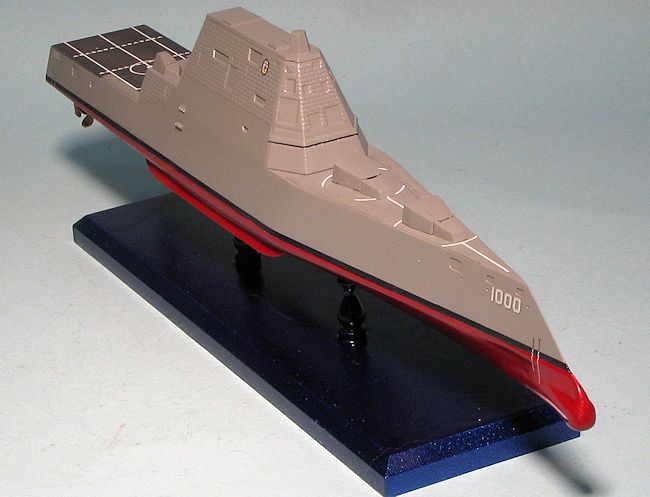 sides wanted to bow out. This also allowed me to glue the large braces on the inside of the hull. Once it dried, it was very sturdy.
sides wanted to bow out. This also allowed me to glue the large braces on the inside of the hull. Once it dried, it was very sturdy.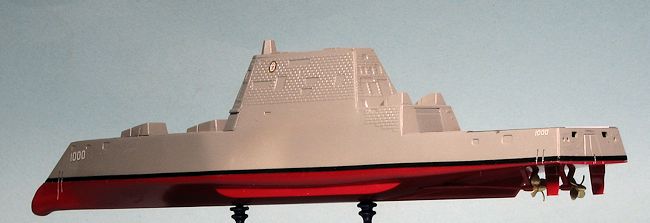 ion. The upper hull was given several coats of clear. Once those areas were painted, I cemented the upper and lower sections together. The flight deck was masked around and since I did not have any FS 36008, I used Tamiya Panzer Grey. Applying decals was not difficult, but the size of some made it a bit tricky. All the white stripe sections are so jammed onto the sheet, that I had to use fine cuticle scissors to cut them out. I used Mr Mark Softer on these and it worked great. Before adding the plimsol lines, I used Microscale 1/16" black stripes for the waterline marking. Once all the decals were in place, the props were painted Brass and glued on. I sprayed the base with a dark blue, deliberately letting it show runs to somewhat simulate water. (You believe that, don't you?). Attempts at building up the helo proved fruitless so that is why there isn't one.
ion. The upper hull was given several coats of clear. Once those areas were painted, I cemented the upper and lower sections together. The flight deck was masked around and since I did not have any FS 36008, I used Tamiya Panzer Grey. Applying decals was not difficult, but the size of some made it a bit tricky. All the white stripe sections are so jammed onto the sheet, that I had to use fine cuticle scissors to cut them out. I used Mr Mark Softer on these and it worked great. Before adding the plimsol lines, I used Microscale 1/16" black stripes for the waterline marking. Once all the decals were in place, the props were painted Brass and glued on. I sprayed the base with a dark blue, deliberately letting it show runs to somewhat simulate water. (You believe that, don't you?). Attempts at building up the helo proved fruitless so that is why there isn't one. | CONCLUSIONS |
Thanks to the rather minimal number of parts, this was a one week build. Actually, I was expecting Tamiya-quality fit and for the most part I got it. There were enough areas of concern to add some building skills into the equation and the result is the first actual non-submarine ship model for me in well over 10 years.
| REFERENCES |
http://en.wikipedia.org/wiki/USS_Zumwalt
Here is a link to an interesting
interactive page on this ship.
June 2015 My thanks to www.dragonmodelusa.com for the review kit. Get yours today at your local retailer or ask them to order it in for you.
If you would like your product reviewed fairly and fairly quickly, please contact the editor
or see other details in the